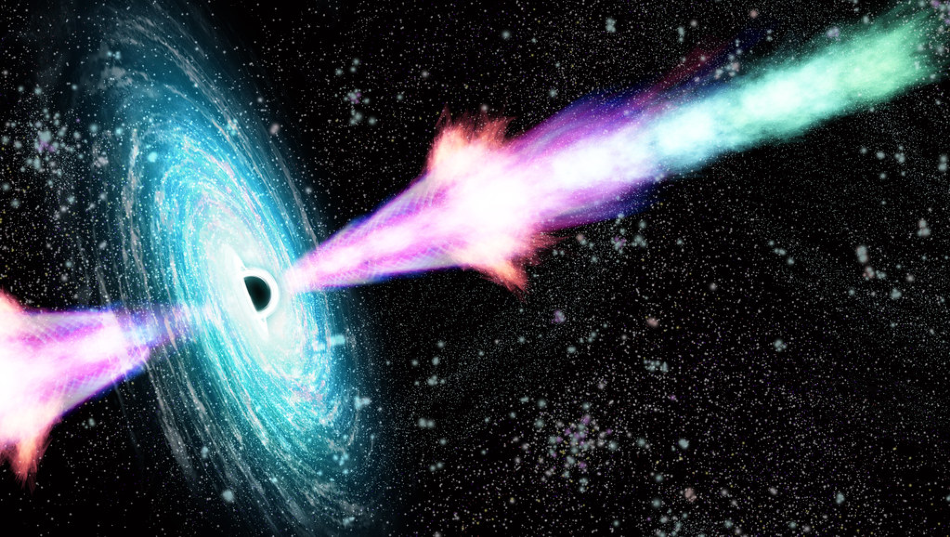Apr 8 2020
When a black hole is formed by the collapse of a massive star in a faraway galaxy, two enormous jets of light-emitting plasma are discharged from its core.
 An artist’s impression of a star’s gamma-ray bursts in the moment after its collapse. Image Credit: Nuria Jordana-Mitjans.
An artist’s impression of a star’s gamma-ray bursts in the moment after its collapse. Image Credit: Nuria Jordana-Mitjans.
These incredibly bright gamma-ray bursts (GRBs) are one of the most powerful explosions in the whole universe. When a jet is pointed toward Earth, it is possible to detect the afterglow from space-borne and ground telescopes.
Materials from an exploding star do not just catapult. In contrast, they accelerate to ultra-high speeds across the narrow beam of the gamma-ray jet. Astrophysicists are clueless about the power source that drives such phenomenal explosions. At present, a new international study spearheaded by the University of Bath looks promising to offer insights into this enigmatic phenomenon.
Several astronomers prefer using the baryonic jet model to explain GRBs. According to that model, repeated intense collisions between materials discharged during the explosion and materials around the dying star create the gamma-ray flash and the ensuing fading afterglow—the dying embers of the growing fireball.
According to a second hypothesis, known as the magnetic model, a huge, primordial magnetic field within the star disintegrates within a few seconds of the initial explosion, thus emitting energy that powers the tremendous blast.
Currently, as a first, an international research team has been able to find evidence that proves this magnetic model. Astrophysicists from the University of Bath collaborated with researchers from the United Kingdom, Spain, Italy, Russia, Slovenia, and South Africa and investigated data from the collapse of an enormous star in a galaxy located 4.5 billion light-years away.
The collapse of the star was known following the detection of its gamma-ray flash (named GRB 190114C) by NASA’s space-borne Neil Gehrels Swift Observatory.
The team observed a strikingly low polarization level in the GRB immediately after the collapse of the star, suggesting that the magnetic field of the star had been destroyed by the explosion.
From previous studies, we expected to detect polarisation as high as 30% during the first hundred seconds after the explosion. So we were surprised to measure just 7.7% less than a minute after the burst, followed by a sudden drop to 2% soon after. This tells us that the magnetic fields collapsed catastrophically straight after the explosion, releasing their energy and powering the bright light detected across the electromagnetic spectrum.
Nuria Jordana-Mitjans, Holder of the Hiroko and Jim Sherwin Postgraduate Scholarship in Astrophysics, University of Bath
Jordana-Mitjans is the lead author of the paper published in The Astrophysical Journal. Although dedicated satellites that orbit the Earth have detected GRBs, it is not feasible to predict when or where a GRB will appear. Therefore, researchers rely on autonomous rapid-response robotic telescopes to capture the fast-fading light of the afterglow.
Just a few seconds following the detection of GRB 190114C by NASA observatory, robotic telescopes located in South Africa and the Canary Islands obtained NASA’s discovery notification and repointed. Within just a minute of the GRB finding, the telescopes started collecting data related to the emissions.
Our innovative telescope systems are entirely autonomous, with no humans in the loop, so they slued very quickly and began taking observations of the GRB almost immediately after its discovery by the Swift satellite. It is remarkable that from the comfort of our own homes, we were able to discover the importance of primordial magnetic fields in powering a cosmic explosion in a distant galaxy.
Carole Mundell, Professor and Head of Astrophysics, University of Bath
Mundell is the co-author of the paper. The GRB study was performed by the University of Bath in partnership with researchers at Liverpool John Moore University, UK; the University of Ferrara, Italy; the University of Nova Gorica, Slovenia; the South African Astronomical Observatory; the Instituto de Astrofisica de Canarias, Spain; Lomonosov Moscow State University and Irkutsk State University, Russia.